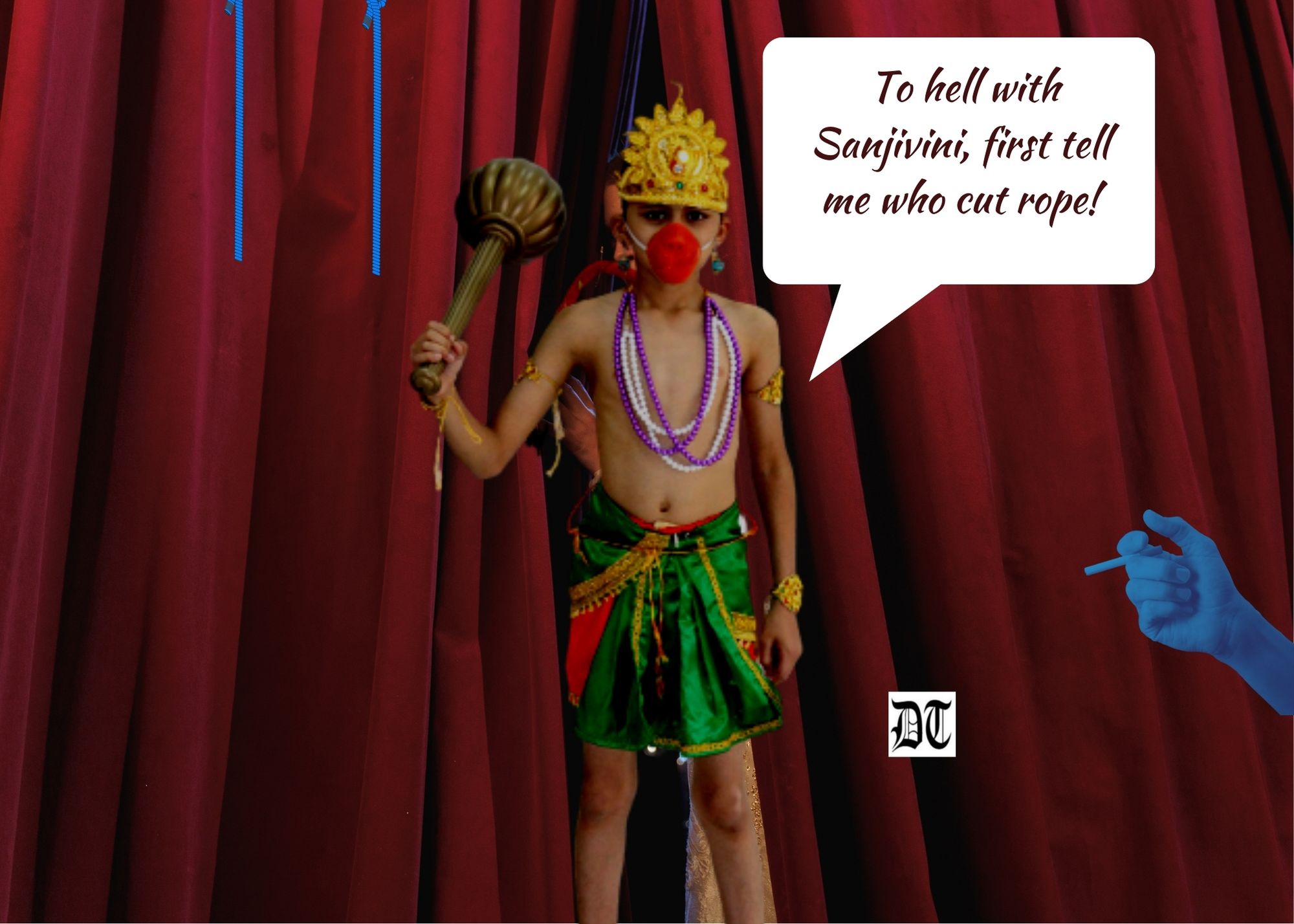Arindam revisits the Ramdal and Ramlila and recalls the terrible faux pas that left Hanuman angry and cussing. He also recalls an incident that his friend, Vijay, told him in Mumbai. His mother was superstitious about an actor playing the role of Rama in a Ramlila nearby. Find out what happened in this humourous piece, as part of the Durga Puja special feature, exclusively in Different Truths.

I grew up in Allahabad enjoying Durga Puja and watching select Ramdals during the 10-day festivity. Since much has been written on Durga Puja, let me dwell on the latter.
Ramdals and Puja together might have been marketed as ‘Allahabad Carnival’ by the UP Tourism Department and the state government. But that was not to be!
Ramdals showcase thematic tableaux from the Ramayana. There are a few contemporary tableaux too. These processions are taken out, locality-wise, throughout the city. Traffic is diverted on those days. Large stretches of streets are lit up brightly with decorative electric bulbs, colourful fluorescent lamps (coloured cellophane paper is wrapped around the fluorescent lamps to create patterns), LED lights, etc. Street-fair springs up. Balloon sellers, roadside eateries, fried groundnuts and grams, chaat shops, flavoured paan (betel), etc., give it a festive look. The garish and loud electric light decoration is called ‘Roshni’ in the local lingo. Other than the Ramadals, there are inter-locality competitions on Roshni.
Huge columns of speakers are piled across each other by contesting groups, each trying to outwit the other at the cost of blasting your eardrums. Pot-bellied policemen are too smug to intervene.
A white ‘Kiran Ghoda’, decorated like a bride, leads the procession daily. Thousands of people, jostling against each other, watch it every year. The strangest part is that little children (teenagers) dressed as Rama, Sita, Lakshmana, and other characters sit like statues, despite the huge many lights, a loud generator car in tow and insects darting all around them. It seems that they get some divine grace to bear it all.
The Ramadal processions are a competitions between two opposing organisers, the two Ramlila Committees, Pattharchatti and Pajawa
The Ramdal processions are competitions between two opposing organisers, the two Ramlila Committees, Pattharchatti and Pajawa. Each of them has a piece de resistance, a show stopper (if we may use the term), and one huge chariot, each made of silver and studded with precious stones. Work on these begins months before as jewellers and artisans work on it every year, changing the patterns. The design, planning, and execution are top secret. After the Ramdal processions, each committee has Ramlilas at assigned grounds. There are many other small Ramlilas too.
I heard from our elders about a faux pas in one such Ramlila play – of course, by a lesser group. The person who traditionally played the role of Hanuman, a coveted role, had a tiff with the organisers. A new Hanuman replaced him. Obviously, the one shoved out did not like it. He decided to avenge the insult.
Injured, bleeding and in terrible pain, this Hanuman was seething with anger.
There used to be a scene when Hanuman would leap over the seas to fetch Sanjivini – a panacea to bring back Lakshmana to consciousness. Hanuman was pulled on a tightrope and pulley that wasn’t visible to the audience. He would return to the hill and the Sanjivini. When he was near the middle of the stage, about to alight, the Monkey-god came crashing onto the stage. He fell on his face and bled profusely. The person playing the role of Rama tried quick damage control. He spoke kindly, “Hanuman, Sanjivini le aye” (Hanuman, have you brought the Sanjivini). Injured, bleeding and in terrible pain, this Hanuman was seething with anger.
He got up and cussed the choicest vituperates, adding, “Bhad mey jaye Sanjivini, pehley ye batha, kisney rassi kati!” (To hell with Sanjivini, first, tell me who cut the rope!)
The audience was rolling in laughter, and the organisers were red-faced. No one says what happened with the one who sabotaged it!
Needless to add that this incident is almost a part of the Ramlila folklore. Years later, I heard the same story at Varanasi and Lucknow. Irrespective of where it happened, it must be true. I am sure the story might be embellished with each narration. I tried to keep it as it is!
Years later, I was in Mumbai – it was Bombay then.
Years later, I was in Mumbai – it was Bombay then. I stayed as a paying guest with my artist friend, Vijay, in Andheri East. He recounted an incident that’s still etched in my memory years later.
He told me that they are Lahori Khatris from Meerut. When his father came to Bombay and started staying in the house they were in, there were hardly any people in that place. Some four or five Housing colonies were there, far from each other. The woods were thick. Foxes and jackals were sighted almost every day.
He was just a young lad, his mother’s darling, the youngest of three children. Those days, his devout mother watched Ramlila every evening with Vijay in tug. She was moved by the youth playing Rama. So much so that she sought permission from the organisers to take him home and serve the Lord with great devotion.
The organisers were too happy to lend him to his mother. It meant feeding one person less.
His mother, with utmost devotion, washed his feet and wiped those with the corner of her saree. She would offer him the Bhog (special vegetarian diet) of Palau, kheer, and other delicacies. She would also offer him halwa made in desi ghee, full of dry fruits. Every day, there would be newer dishes for the ‘God’. After a sumptuous lunch, the god went out for a long walk every afternoon.
She was shocked to see that Rama was smoking a Bidi. His eyes closed in divine bliss!
Vijay was envious of all the respect, love and attention that Rama was getting. He stealthily followed Rama and saw that he crouched behind the boundary of their home at the rear end. Rama hid behind the small shrubs and a large tree. He watched intently.
He ran in and dragged his mother out, saying Rama called her. She followed him in haste. She pointed out where Rama hid. His mother quietly tiptoed behind him. She was shocked to see that Rama was smoking a Bidi. His eyes closed in divine bliss!
She hollered at him and dragged him out, much to the utter shock and dismay of the confused Rama. She chided him and threw him out of her home.
The good times for Rama ended. But it began for Vijay!
Picture design Anumita Roy, Different Truths






 By
By
 By
By
Had me in fits — & a great punch line!
Thank you so much, Azam ji